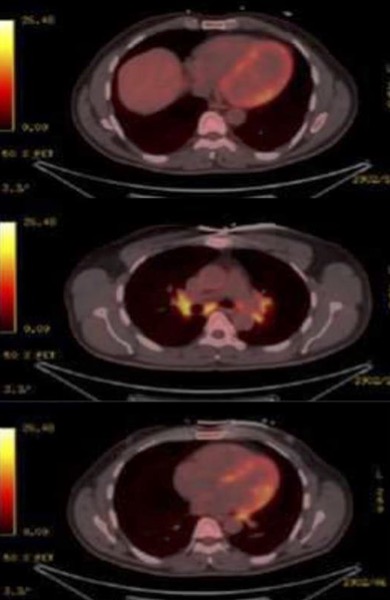Cardiac Sarcoidosis Managed by Biventricular Pacing: A Case Report
DOI:
https://doi.org/10.38179/ijcr.v3i1.147Keywords:
Cardiac sarcoidosis, Granulomatous disease, Atrioventricular block, Biventricular pacing, Case reportAbstract
Background: Cardiac sarcoidosis (CS) is a rare pathology that affects the middle-aged population. Its diagnosis, as well as its treatment, can be quite challenging, especially dealing with device management. We hereby discuss a case of CS, managed by a biventricular pacemaker in a 43-year-old man.
Case Report: A 43-year-old male presented to the emergency department with a 15-day history of chronic cough and worsening dyspnea. On examination, he was found to be bradycardic in the context of a third-degree heart block on ECG as well as bilateral hilar lymphadenopathy on chest radiography. Based on these findings, cardiac sarcoidosis was suspected. A temporary right internal jugular transvenous pacemaker was implanted in the right ventricle and empiric corticosteroid management was commenced. Lung tissue biopsies were obtained via bronchoscopy and were positive for granulomas consistent with a diagnosis of sarcoidosis. Even though the patient showed a partial positive response to corticosteroid treatment, he required a permanent pacemaker. A dual-chamber implantable cardioverter-defibrillator (ICD) was implanted and the patient was discharged on prednisone. His follow-up plan consisted of serial echocardiography and consideration of a new coronary sinus lead in the event of left ventricular dysfunction in the future.
Conclusion: Cardiac rhythm management in the context of CS is often difficult, with decisions that need to be made between a pacemaker, a defibrillator, or a cardiac resynchronization device. The idea that biventricular pacing has a preventative role against heart failure in patients with normal left ventricular ejection fraction and CS deserves more attention and discussion.
References
Sekhri V, Sanal S, DeLorenzo LJ, Aronow WS, Maguire GP. Cardiac sarcoidosis: A comprehensive review. Archives of Medical Science. 2011;4:546–54. https://doi.org/10.5114/aoms.2011.24118
Hulten E, Aslam S, Osborne M, Abbasi S, Bittencourt MS, Blankstein R. Cardiac sarcoidosis-state of the art review. Cardiovasc Diagn Ther. 2016 Feb;6(1):50-63. PMID: 26885492. https://doi.org/10.3978/j.issn.2223-3652.2015.12.13
Jayakrishnan B, Al-Busaidi N, Al-Mubaihsi S, Al-Rawas OA. Sarcoidosis in the Middle East. Ann Thorac Med. 2019;14(2):106-115. PMID: 31007761. https://doi.org/10.4103/atm.ATM_227_18
Behbehani N, JayKrishnan B, Khadadah M, Hawa H, Farah Y. Clinical presentation of sarcoidosis in a mixed population in the middle east. Respir Med. 2007;101(11):2284-2288. PMID: 17697768. https://doi.org/10.1016/j.rmed.2007.06.025
Kusano KF, Satomi K. Diagnosis and treatment of cardiac sarcoidosis. Heart. 2015;102(3):184–90. https://doi.org/10.1136/heartjnl-2015-307877
Chopra HK, Nanda NC, Narula J. Advances & innovations in heart failure (AIHF): A textbook of cardiology. New Delhi, India: Jaypee Brothers Medical; 2020.
Birnie DH, Sauer WH, Bogun F, Cooper JM, Culver DA, Duvernoy CS, et al. HRS expert consensus statement on the diagnosis and management of arrhythmias associated with cardiac sarcoidosis. Heart Rhythm. 2014;11(7):1304–23. PMID: 24819193. https://doi.org/10.1016/j.hrthm.2014.03.043
Pour-Ghaz I, Kayali S, Abutineh I, et al. Cardiac Sarcoidosis: Pathophysiology, Diagnosis, and Management. Hearts. 2021;2(2):234-250. https://doi.org/10.3390/hearts2020019
Zhou Y, Lower EE, Li HP, Costea A, Attari M, Baughman RP. Cardiac Sarcoidosis: The Impact of Age and Implanted Devices on Survival. Chest. 2017;151(1):139-148. PMID: 27614001. https://doi.org/10.1016/j.chest.2016.08.1457
JCS Joint Working Group. Guidelines for diagnosis and treatment of myocarditis (JCS 2009): digest version. Circ J. 2011;75(3):734-43. Epub 2011 Feb 4. PMID: 21304213. https://doi.org/10.1253/circj.cj-88-0008
Slart RH, Glaudemans AW, Lancellotti P, Hyafil F, Blankstein R, Schwartz RG, et al. A joint procedural position statement on imaging in cardiac sarcoidosis: From the cardiovascular and Inflammation & In-fection Committees of the European Association of Nuclear Medicine, the European Association of Cardiovascular Imaging, and the American Society of Nuclear Cardiology. European Heart Journal - Cardiovascular Imaging. 2017;18(10):1073–89. PMID: 28984894. https://doi.org/10.1093/ehjci/jex146
Kandolin R, Lehtonen J, Airaksinen J, Vihinen T, Miettinen H, Ylitalo K, Kaikkonen K, Tuohinen S, Haataja P, Kerola T, Kokkonen J, Pelkonen M, Pietilä-Effati P, Utrianen S, Kupari M. Cardiac sarcoidosis: epidemiology, characteristics, and outcome over 25 years in a nationwide study. Circulation. 2015 Feb 17;131(7):624-32.. Epub 2014 Dec 19. PMID: 25527698. https://doi.org/10.1161/CIRCULATIONAHA.114.011522
Yazaki Y, Isobe M, Hiroe M, Morimoto S-ichiro, Hiramitsu S, Nakano T, et al. Prognostic determinants of long-term survival in Japanese patients with cardiac sarcoidosis treated with prednisone. The American Journal of Cardiology. 2001;88(9):1006–10. https://doi.org/10.1016/s0002-9149(01)01978-6
Kazmirczak F, Chen K-HA, Adabag S, von Wald L, Roukoz H, Benditt DG, et al. Assessment of the 2017 AHA/ACC/HRS guideline recommendations for implantable cardioverter-defibrillator implantation in cardiac sarcoidosis. Circulation: Arrhythmia and Electrophysiology. 2019;12(9). https://doi.org/10.1161/CIRCEP.119.007488
Chan JY-S, Fang F, Zhang Q, Fung JW-H, Razali O, Azlan H, et al. Biventricular pacing is superior to right ventricular pacing in bradycardia patients with preserved systolic function: 2-year results of the pace trial. European Heart Journal. 2011;32(20):2533–40. https://doi.org/10.1093/eurheartj/ehr336
Fang F, Sanderson JE, Yu C-man. Should all patients with heart block receive biventricular pacing? Circulation: Arrhythmia and Electrophysiology. 2015;8(3):722–9. https://doi.org/10.1161/CIRCEP.114.000626
Stockburger M, Gómez-Doblas JJ, Lamas G, et al. Preventing ventricular dysfunction in pacemaker patients without advanced heart failure: results from a multicentre international randomized trial (PREVENT-HF). Eur J Heart Fail. 2011;13(6):633-641. PMID: 21613427. https://doi.org/10.1093/eurjhf/hfr041
The DAVID Trial Investigators. Dual-chamber pacing or ventricular backup pacing in patients with an implantable defibrillator. JAMA. 2002;288(24):3115. https://doi.org/10.1001/jama.288.24.3115
Funck RC, Blanc J-J, Mueller H-H, Schade-Brittinger C, Bailleul C, Maisch B. Biventricular stimulation to prevent cardiac desynchronization: Rationale, design, and endpoints of the ‘biventricular pacing for atrioventricular block to prevent cardiac desynchronization (biopace)’ study. EP Europace. 2006;8(8):629–35. https://doi.org/10.1093/europace/eul075
Barold SS. What is cardiac resynchronization therapy?. Am J Med. 2001;111(3):224-232. PMID: 11530034. https://doi.org/10.1016/s0002-9343(01)00807-5
Essebag V, Joza J, Birnie DH, Sapp JL, Sterns LD, Philippon F, et al. Incidence, predictors, and pro-cedural results of upgrade to resynchronization therapy. Circulation: Arrhythmia and Electrophysiology. 2015;8(1):152–8. https://doi.org/10.1161/circep.114.001997

Published
How to Cite
Issue
Section
Copyright (c) 2022 International Journal of Clinical Research

This work is licensed under a Creative Commons Attribution 4.0 International License.







